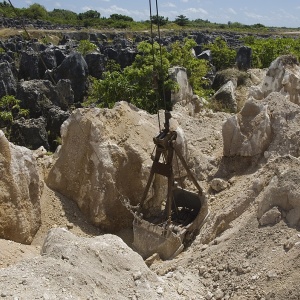
This paper maps the potential for different subnational, national, or regional areas to reduce their agricultural dependence on imported phosphorus fertiliser by recycling manure or urban waste (including both human excreta and household and industrial wastes).
The paper divides the world map into hexagonal grid “cells” of an average area of 290 km2 each. For each cell, information on cropland extent, livestock density and human population density was used to estimate phosphorus flows.
The authors suggest that those cells where there is both a large area of cropland and a ready supply of phosphorus (in the form of animal or human manure) offer an opportunity for recycling phosphorus locally and reducing phosphorus fertiliser requirements. Manure‐rich cultivated areas account for 12% of global grid cells (49% of cultivated area worldwide), while populous cultivated areas account for 11% of grid cells and 45% of cultivated area.
The paper also finds that two-thirds of nations have a high dependence on imported phosphorus fertiliser (‘high’ being defined as net fertiliser imports having a quantity of 40% or more of the nation’s total phosphorus fertiliser consumption).
Abstract
Food production hinges largely upon access to phosphorus (P) fertilizer. Most fertilizer P used in the global agricultural system comes from mining of nonrenewable phosphate rock deposits located within few countries. However, P contained in livestock manure or urban wastes represents a recyclable source of P. To inform development of P recycling technologies and policies, we examined subnational, national, and global spatial patterns for two intersections of land use affording high P recycling potential: (a) manure‐rich cultivated areas and (b) populous cultivated areas. In turn, we examined overlap between P recycling potential and nation‐level P fertilizer import dependency. Populous cultivated areas were less abundant globally than manure‐rich cultivated areas, reflecting greater segregation between crops and people compared to crops and livestock, especially in the Americas. Based on a global hexagonal grid (290‐km2 grid cell area), disproportionately large shares of subnational “hot spots” for P recycling potential occurred in India, China, Southeast Asia, Europe, and parts of Africa. Outside of China, most of the remaining manure‐rich or populous cultivated areas occurred within nations that had relatively high imports of P fertilizer (net P import:consumption ratios ≥0.4) or substantial increases in fertilizer demand between the 2000s (2002–2006) and 2010s (2010–2014). Manure‐rich cultivated grid cells (those above the 75th percentiles for both manure and cropland extent) represented 12% of the global grid after excluding cropless cells. Annually, the global sum of animal manure P was at least 5 times that contained in human excreta, and among cultivated cells the ratio was frequently higher (median = 8.9). The abundance of potential P recycling hot spots within nations that have depended on fertilizer imports or experienced rising fertilizer demand could prove useful for developing local P sources and maintaining agricultural independence.
Reference
Powers, S.M., Chowdhury, R.B., MacDonald, G.K., Metson, G.S., Beusen, A.H.W., Bouwman, A.F., Hampton, S.E., Mayer, B.K., McCrackin, M.L. and Vaccari, D.A., 2019. Global Opportunities to Increase Agricultural Independence through Phosphorus Recycling. Earth's Future, Early view.
Read the full paper here. See also the Foodsource resource How do the climate and environment directly affect the conditions required for food production?







Post a new comment »